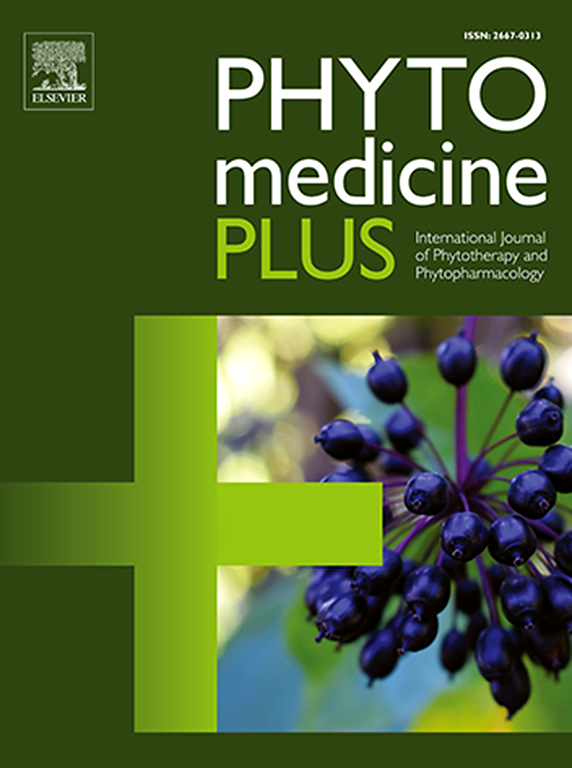用体外、体内和计算机方法评价荆荆壁茎皮乙醇提取物对四氯化碳(CCl4)诱导的肝损伤的抗氧化和肝保护活性
Q3 Pharmacology, Toxicology and Pharmaceutics
引用次数: 0
摘要
在孟加拉国的Rangamati,山茱萸的各种成分传统上被用来治疗黄疸(树皮)、尿道炎(树皮)、月经大出血(根)、糖尿病和疟疾(叶子、树皮)。为了验证这种植物的治疗功效,目前的研究工作进行了各种植物化学和药理学研究,以评估从荆梗树皮提取的乙醇提取物的肝脏保护和抗氧化活性。在Sprague-Dawley大鼠四氯化碳(CCl4)肝损伤实验中,以250和500 mg/kg剂量给药,每日1次。经提取物处理后,血清酶水平明显恢复到接近正常水平。通过定量测定血清谷氨酸丙酮酸转氨酶(SGPT)、谷氨酸草酰乙酸转氨酶(SGOT)、丙氨酸磷酸酶(ALP)等生化指标来评估保护水平。水飞蓟素作为标准参比,对四氯化碳引起的大鼠肝毒性具有显著的肝保护作用。本研究结果清楚地表明,荆梗梗皮对四氯化碳诱导的大鼠肝损伤具有显著的肝保护作用,结果具有统计学意义(P<0.001)。在进行DPPH清除实验时,发现提取物的IC50值为289.170µg/ml。对干燥后的植物材料进行检测,发现其酚类含量为78.408 mg GAE/g,类黄酮含量为89.983 mg QE/g,单宁含量为84.983 mg GAE/g。经H2O2清除率测定,提取液的SC50为185.092 mg/l。木犀草素、熊果酸、叶黄素和叶黄素是已被鉴定为具有抗氧化作用和体内保护肝脏潜能的化合物。这是由一些显着的植物化学物质的存在和使用这些化合物进行的硅对接研究表明。提取物中黄酮类化合物的存在所带来的自由基清除能力的潜力是导致这种治疗潜在作用的可能机制之一。有必要进行进一步的研究,以了解确切的作用机制和负责药理反应的植物成分。本文章由计算机程序翻译,如有差异,请以英文原文为准。
Evaluation of antioxidant and liver protective activity of ethanolic extract of Vitex peduncularis wall (Lamiaceae) stem bark against carbon tetrachloride (CCl4) induced liver damage using in –vitro, in- vivo and in-silico approaches
Various components of Vitex peduncularis Wall are traditionally employed for treating jaundice (bark), urethritis (bark), heavy menstrual bleeding (root), diabetes, and malaria (leaves, bark) in Rangamati, Bangladesh. To validate the therapeutic claim of this plant, current work has conducted various phytochemical and pharmacological investigations to assess the liver protective and antioxidant activities of the ethanol extract from the stem bark of Vitex peduncularis. In carbon tetrachloride (CCl4) induced hepatic damage test using Sprague-Dawley rats, the extracts at a dose of 250 and 500 mg/kg were administered orally once daily. The markedly increased serum enzyme levels were significantly returned to near-normal levels by the extracts. The level of protection was assessed by quantifying biochemical indicators such as serum glutamate pyruvate transaminase (SGPT), serum glutamate oxaloacetate transaminase (SGOT), and alanine phosphatase (ALP). Silymarin served as a standard reference and demonstrated considerable hepatoprotective efficacy against carbon tetrachloride-induced hepatotoxicity in rats. The findings of this study clearly demonstrate that Vitex peduncularis stem bark possesses significant liver protective effects against carbon tetrachloride-induced liver injury in rats, with statistically significant results (P<0.001). When doing the DPPH scavenging experiment, it was revealed that the extract had an IC50 value of 289.170 µg/ml. When the dried plant material was examined, it was discovered that the phenolic content, flavonoid content and tanin contents were 78.408 mg GAE/g, 89.983 mg QE/g and 84.983 mg GAE/g respectively. The SC50 of the extract was determined to be 185.092 mg/l when it was subjected to the H2O2 scavenging assay. Luteolin, Ursolic acid, Friedelinol, and Epifriedelinol are the compounds that have been identified as being responsible for the antioxidant and in vivo liver protective potential of Vitex peduncularis bark extract. This is indicated by the presence of a number of notable phytochemicals and the in-silico docking study that was performed using these compounds. The potential for free radical scavenging capacity that is brought about by the presence of flavonoids in the extracts is one of the possible mechanisms that could be responsible for this therapeutically potential action. It is necessary to conduct additional research in order to investigate the precise mechanism of action and phytoconstituents that are responsible for the pharmacological response.
求助全文
通过发布文献求助,成功后即可免费获取论文全文。
去求助
来源期刊

Phytomedicine Plus
Medicine-Complementary and Alternative Medicine
CiteScore
3.70
自引率
0.00%
发文量
178
审稿时长
81 days
期刊介绍:
 求助内容:
求助内容: 应助结果提醒方式:
应助结果提醒方式:


